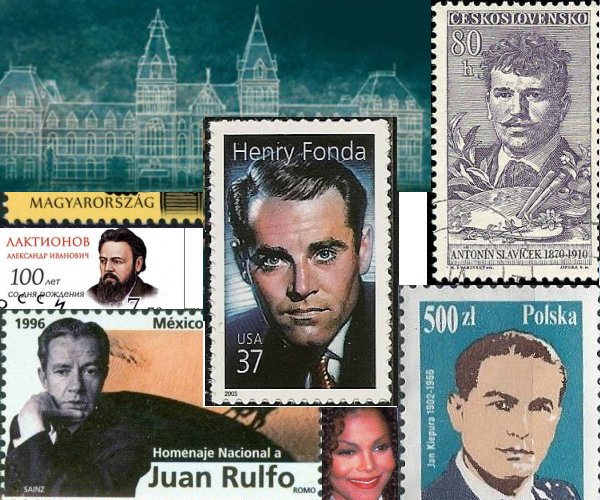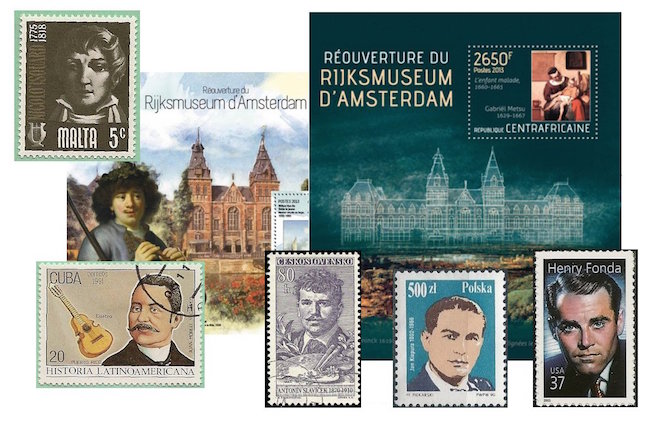The Arts on the Stamps of the World — May 16
An Arts Fuse regular feature: the arts on stamps of the world.

By Doug Briscoe
There are no colossi (well, maybe Henry Fonda) among today’s artists on the Stamps of the World, but there should be. It amazes me that Germany has never issued a stamp honoring poet Friedrich Rückert (16 May 1788 – 31 January 1866), whose verses have inspired so many of the great composers (Schubert, Schumann, Brahms, Strauss, Mahler, speaking of colossi).
One would expect a philatelic acknowledgement of Austrian-Jewish tenor Richard Tauber (1891 – 8 January 1948), American big band leader Woody Herman (1913 – October 29, 1987), and the great Japanese director Kenji Mizoguchi (1898 – August 24, 1956), too. Instead, we honor those who strove but never quite had greatness ( = worldwide name recognition) thrust upon them.
Earliest born among today’s entries was Maltese composer Nicolas (or Nicolò) Isouard (1773 – March 23, 1818), who studied with Francesco Azopardi as well as in Palermo and Naples. At the turn of the century he moved to Paris, where he remained for the rest of his life, making a living as a composer of sacred music and operas, several of which were collaborations with his friend Rodolphe Kreutzer. One of his earlier operas, performed in Malta in 1796, was yet another Barber of Seville (twelve years after the one by Paisiello and twenty years before Rossini’s).
The remarkably prolific Dutch architect Pierre Cuypers (16 May 1827 – 3 March 1921) built or restored a great many churches, other buildings, and monuments in the Netherlands. His grandest works are the Amsterdam Central Railway Station (1881–1889) and the Rijksmuseum (1876–1885), both in Amsterdam. He himself remains philatelically neglected, but the grand Rijksmuseum can be seen on handsome souvenir sheets from the Central African Republic and Togo.

Juan Morel Campos’s name is sometimes incorrectly spelled “Morell” (as it is on the stamp!). Born May 16, 1857 to parents from the Dominican Republic and Venezuela, Morel learned to play a variety of brass instruments and was a founder and director of the Firemen’s Band of his native Ponce. Later he had his own dance orchestra, “La Lira Ponceña”, for which he wrote most of his 300 danzas, a form he is credited with having raised to a level of expressive refinement. Many of these can be heard in Morel’s own piano versions, like this one recorded by Jesús Maria Sanromá. There are some 250 further compositions including waltzes, marches, overtures. He died young, just four days before his 39th birthday, May 12, 1896. The Juan Morel Campos Secondary School in Brooklyn is named for him. The stamp is one of a series of Cuban issues commemorating Latin American composers.
Czech painter Antonín Slavíček (1870 – 1 February 1910) is held to be the leading Czech artist of his day, in particular around 1900. About ten years later he suffered two successive crushing blows, a broken hand and then the next year a stroke that left him paralyzed. He attempted to teach himself to paint with his left hand, but in hopeless frustration committed suicide by shooting himself. Although the Czech stamp gives us an idea of what the man looked like, I could find no stamps showing any of his work, so I thought I’d provide a couple of links to images: In Veltrus Park (1896), In Our Kameničky (1904), and Letna Park (1907).
The Polish tenor and actor Jan Kiepura was born on May 16, 1902. His first solo appearance was in the opera Halka by Moniuszko (I like to call it The Incredible Halka), but his first starring rôle was as Gounod’s Faust in 1925. His career took off from there, and his financial success from European tours was such that he built an hotel in Poland with the proceeds. His wife was soprano and actress Marta Eggerth, who died just four years ago at the age of 101. They both appeared in many films and often performed together. They emigrated to the US in 1937. Kiepura debuted at the Met in 1938 and died in New York on August 15, 1966.
Three years younger than Kiepura was the much celebrated American actor (and acting dynasty founder) Henry Fonda (1905 – August 12, 1982). His work in such fine films as The Ox-Bow Incident, The Grapes of Wrath, Mister Roberts (Fonda actually did serve three years in the Navy during World War II), 12 Angry Men, and Once Upon a Time in the West has assured his place in film history. An interesting note: his Italian ancestors migrated to the Netherlands in the 15th century, and one branch of the family came to North America as early as 1642.
Aleksandr Laktionov (1910 – 15 March 1972) was a Russian painter whose work epitomized Socialist Realism. His art was very popular but found its critics among those who saw his representations of daily Soviet life as exaggeratedly positive, suggesting a greater comfort among the people than was the reality. Laktionov was born in Rostov-on-Don and had his first success with Letter From the Front (1947), as seen on the 1973 stamp I’ve superimposed over the centennial postal card, which features In Summer (1951-4). Other titles like Into a New Flat (1952) and Old Age Provided For (1958–60) will give you an idea of his general subject matter.

Today is the centenary of Mexican writer Juan Rulfo (16 May 1917 – 7 January 1986), known mainly for his short story collection El Llano en llamas (1953), and the 1955 novel Pedro Páramo, but he also wrote screenplays and was active as a photographer (a collection of his photographs, Juan Rulfo’s Mexico, has been published). Born Juan Nepomuceno Carlos Pérez Rulfo Vizcaíno in Jalisco, he was an orphan by the age of ten and brought up by his grandmother. He studied law and literature at the National Autonomous University of Mexico and co-founded a literary journal, Pan, in 1944. The short novel Pedro Páramo was an important inlfuence on Gabriel García Márquez and other Latin American writers. García Márquez credits the book with helping him overcome his writer’s block and produce his masterpiece, One Hundred Years of Solitude. He believed that Rulfo’s small output was comparable in scope and in durability to the surviving work of Sophocles.
The short-lived French film actress Martine Carol (1920 – 6 February 1967) was perhaps the leading sex symbol and certainly the top box office draw of late 40s and 50s France, likened to Marilyn Monroe. Today she is probably best remembered for her starring role in Max Ophüls’ Lola Montès (1955). Her life was troubled, with drug abuse and at least one suicide attempt. The first of her four marriages was to Lana Turner’s ex-husband Stephen Crane. Carol succumbed to a heart attack in Monte Carlo while working on a film.
Irish actor Pierce Brosnan (born 16 May 1953) shows up on a couple of stamps for his James Bond roles: he was in four of them between 1995 and 2002 (GoldenEye, Tomorrow Never Dies, The World Is Not Enough, and Die Another Day). Having studied art in his youth, Brosnan enjoys painting and regularly donates the proceeds from the sale of his work to charity. His life has not been free of tragedy—his first wife and their daughter both died young of ovarian cancer.
It’s also Janet Jackson’s birthday. The youngest member of the Jackson clan, she turns 51 today. Her stamp comes from a Rwandan sheet celebrating American entertainers.
A graduate of the University of Massachusetts with a B.A. in English, Doug Briscoe worked in Boston classical music radio, at WCRB, WGBH, and WBUR, for about 25 years, beginning in 1977. He has the curious distinction of having succeeded Robert J. Lurtsema twice, first as host of WGBH’s weekday morning classical music program in 1993, then as host of the weekend program when Robert J.’s health failed in 2000. Doug also wrote liner notes for several of the late Gunther Schuller’s GM Recordings releases as well as program notes for the Boston Classical Orchestra. For the past few years he’s been posting a Facebook “blog” of classical music on stamps of the world, which has now been expanded to encompass all the arts for The Arts Fuse.
